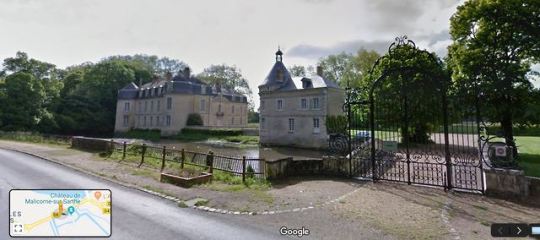#louis boudan
Text

François de Bourbon, Prince de Conti. Par Louis Boudan.
7 notes
·
View notes
Photo

Claude Lefèbvre - Self-portrait - ca. 1683
Claude Lefèbvre (12 September 1632 (baptised) - 25 April 1675) was a French painter and engraver.
Lefèbvre was born at Fontainebleau, the son of the painter Jean Lefèbvre (1600–1675), and became a member of the workshop of Claude d'Hoey (1585–1660) at Fontainebleau. In 1654 he studied with Eustache Le Sueur in Paris, and after Le Sueur's death in 1655, with Charles Le Brun. Under Le Brun he probably assisted in the preparation of cartoons (untraced) for the tapestry series History of the King (Château of Versailles) and painted a Nativity (untraced) for Louis XIV, but Le Brun found Lefèbvre's compositions poor and encouraged him to specialize in portraiture.
Lefèbvre soon established himself as a leading portrait artist, and in 1663, at the age of thirty, he was received (reçu) as a member of the Académie Royale de peinture et de sculpture in anticipation of his portrait of Jean-Baptiste Colbert (Château of Versailles). Lefèbvre spent several years creating the portrait and finally presented it on 30 October 1666. He was an assistant professor at the Académie beginning in 1664. Among his students were François de Troy and Jean Cotelle, le jeune.
Lefebvre visited England, where he appears to have been influenced by the work of Anthony van Dyck. In London he was invited to paint at the court of King Charles II of England. His work is included in major collections such as the National Portrait Gallery, London, and the Louvre.
At the peak of his career, at the Salon of 1673, he presented ten pictures, of which nine were portraits. Few of Lefèbvre's paintings have survived, and many are known only from engravings by artists such as Gérard Edelinck, Nicolas de Poilly and Pieter van Schuppen. Based on the evidence from engravings, several paintings have been attributed to Lefèbvre, including the portrait of Charles Couperin with the Artist's Daughter (Château of Versailles).
Lefèbvre was also an engraver. His engravings include a Self-portrait and a portrait of Alexandre Boudan.
Claude Lefèbvre died in Paris. He is sometimes confused with Rolland Lefèbvre, a portrait painter who died in London in 1677.
20 notes
·
View notes
Text
A Night at the Opera
18/09/2019: Tonight we are getting a bit of culture, namely opera at Palais Garnier but first it was Sacré-Cœur at Montmartre.
The usual start today, up the street early for croissants, an easy breakfast followed by heading out to Montmartre via the Metro around 11am. We caught the wrong train though. Some English dude told us to get off and catch the next train back. Second time lucky, Shane said there was a funicular to take us up the steep climb to the basilica. From Sant Michel we travelled on Line 4 to Barbès – Rochechouart. There was a funicular around somewhere but we couldn't find it. We must have gone the wrong way. The way we chose seen us walking along Boulevard de Rochechouart before turning right and ending up walking up the steep climb that was Rue Muller. This turned into a stairs that was called Rue Maurice Utrillo. We veered left, avoiding the stairs and walked up the pathway through the leafy gardens of Square Louise-Michel, below Sacré-Cœur. With a few stops on the park benches Jo's jelly legs eventually made it to the top of the park where three fountains all spilling into a common pond overshadowed a viewing area over Paris. Unfortunately, the fountains were in a state of disrepair and the pond bone dry. The next set of steps took us up to the viewing platform above the fountains and the third set of steps to Rue du Cardinal Dubois, the road crossing directly below Sacré-Cœur, all the way ignoring the usual selfie stick, souvenir peddlers and sellers of kid's wooden letters on wheels.
We stopped here for a while and looked around. It was quite a view but not too many Parisienne landmarks could be easily identified but with some with the help from the panorama map with site seeing arrows on the platform balustrade we spotted some.

We avoided Rue Maurice Utrillo and took the path instead
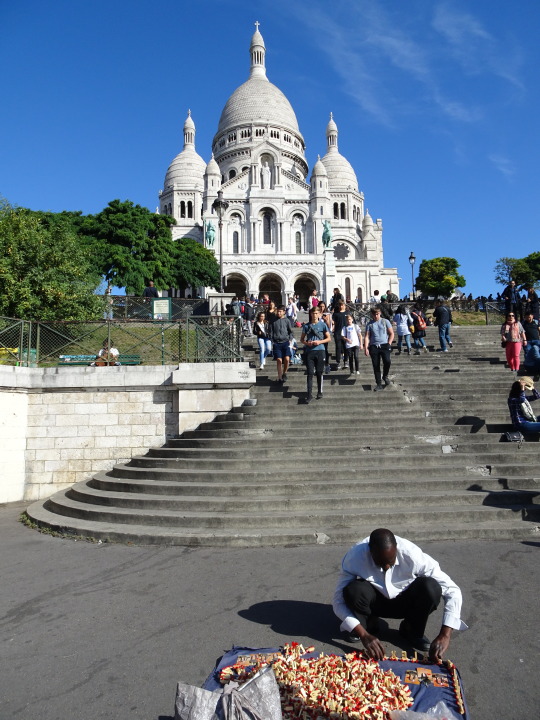
Toy seller
This basilica was constructed only recently, as recently as the late eighteen hundreds. But apparently, from the "dawn of time" Montmartre or the Mount of the Martyrs has been a place of worship. The Druids kicked it off through to the Roman temples of Mars and Mercury and the Church of Saint Peter, the oldest in Paris, rebuilt in the 12th century next to the Royal Abbey of Montmartre by Louis VI and his wife Adélaïde de Savoie.
Saint Geneviève, who lived in the fifth century introduced Saint Denis to the locals. He went on to be the first Bishop of Paris and also the first martyr. Well done Geneviève. Christians triumphed “not by fighting, but by dying”. Three hundred years later the chapel that was built on the mound following Denis's martyrdom fell apart and another was built. Mont des Martyrs was so named to commemorate all of the unknown Christians that were martyred during the persecutions. After a few more destructions and reconstructions over the centuries, what you see is what you get.
By climbing yet another set of stairs we headed into the basilica. Upon entering the nave we found that sightseers were separated from worshippers by blocking off the centre aisle. This wasn't the case on the outside ones. This service was interesting as sermon was taking place, several nuns provided the music while people prayed. This continued after the service as well. The apse and altar were particularly interesting, with a large blue and gold image of Jesus the centre piece of the domed ceiling with what could only be described as wise men or disciples on either side. With the columns holding the joint up not totally connected with walls, a walk around the back of the altar gave a great and differing perspective of what was going on above.
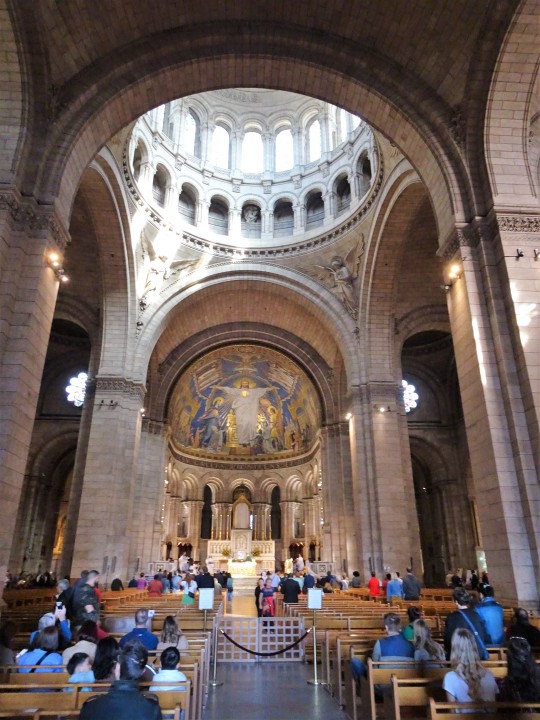
From the nave to the altar

Disciples or angels or something
Upon leaving the basilica, Shane decided to climb the dome. Jo didn't. She instead attended Mass and lit a candle for Cecilia and another dear friend, Pierre Boudan who passed away two weeks earlier. She then placed a lock to commemorate Cec and their time in Paris only a year earlier.
Two hundred and seventy steps and numerous rests after paying for the privilege, the climb was finished and Shane was at the top. It was not a straight forward climb as several roofs needed to be scaled via there were spiral stairs to the roof tops, stairs over the ridges and them back down again and then more spiral stairs. Quite tiring. Once at the top there were good views all around.

From the very top to the very bottom
You can only look at a view for so long, and as Steve Newman once said, "All views are boring after a while." he wasn't far wrong yet we still pursue them. Ten minutes at the top was enough and five minutes after that we were both together again, down on Parvis du Sacré-Cœur and next to the tourist train. The next thing was a toilet so we descended the stairs to Rue du Cardinal Dubois and found what we thought was a restaurant and bar next to the funicular. It was neither but a shop with minimal stock. A sign out the front spruiking a bar was not yet in effect. We were a couple of weeks early. The main thing was that for the obligatory fifty cents, the toilet was available.
While Jo was in the toilet, Shane looked around outside, paying attention to the funicular and the benefit of catching a ride. It may have saved some energy on the way up but definitely not on the way down. It only went a few flights of stairs and then a walk to the bottom after that. As well as the funicular research he also found a watering hole in the shape of an Irish pub immediately below the top shop. When Jo resurfaced we both headed into the bar for a beer and a free toilet. We found a spot in the sun by a window and took it easy for a while.
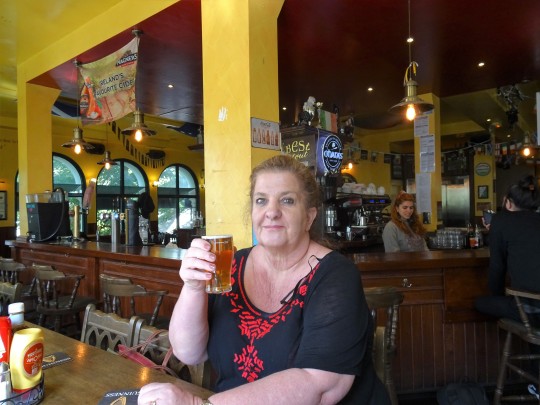
Cheers, big ears
From there it was back down to a packed street level where we walked amongst the crowd until we found Barbès – Rochechouart Metro for the trip back. On the way to the basilica the streets were full of hair dressers and beauty people, on the way back the streets were full of fabric sellers. Colours galore.
By not long after seven we were walking to the opera, La Traviata at Palais Garnier. Knowing that the opera house was near the apartment that we stayed in last year, we crossed the Seine on Pont des Arts and headed through the Louvre forecourt. There was a lot of work going on around the place resulting in footpaths being closed and detours through Louvre courtyards that we hadn't been before. We just followed the crowd and ended up in Cour Napoléon et Pyramide du Louvre next to the glass pyramid. Once we crossed Rue de Rivoli we headed up Avenue de l'Opéra and within ten minutes we were there.
After showing our tickets to security we bought a programme for fifteen euro and queued for champagne and water. There was just enough time as we weren't that early so after downing our champers we headed off to our boxes, Shane to the right second row (loge de face 31-35, Place 14), Jo to the left second row (loge de face 32-36, Place 14). For those uncultured it means Front box via doors 32-36, seat 14 which was the end seat in the second row. What we didn't realise when booking, not that they gave us a choice, was that we thought that Place 14 would sit us in the same box. Not the same seat on different sides of the theatre.
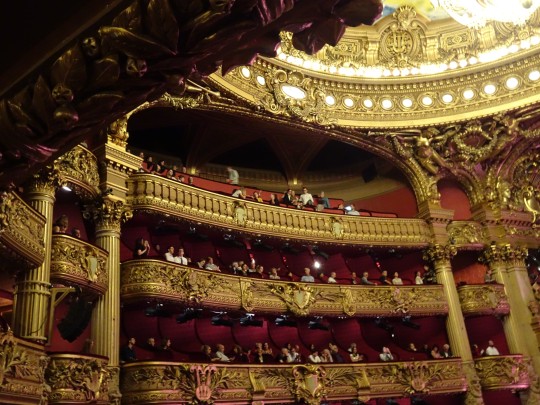
The crowd filing into their loge de face
The theatre was splendid with strange stage setup and band warming up. The box was quite cramped though. Jo had a good view but Shane had some big boof head in front and couldn't see. As the box filled a tall dude with a Jimmy Hendrix afro sat down a couple of seats away and one row back. He pitied the person behind him as he wouldn't have seen a thing.
The set was on a large circular base that would spin around as required. It was quite high, maybe five to six metres with an external corner on one side and a large circular convex shape on the inside. It was like putting a square prism on a circular rotating base, removing a circular prism from its centre and cutting it in half diagonally. Quite clever as no time was lost changing sets as the opera was designed around building a set on the reverse side of the set being used. The two external faces of the set were for small props and largely a video backdrop whereas the internal semi-circular face was for when more substantial props were required.

The rectangular part of the stage, the other side convexed
Verdi's La Traviata debuted in 1853 and was highly controversial for its day. Unlike her literary peers, heroine and courtesan Violetta was smart, sensitive and from good breeding stock but was plagued by bourgeois hypocrisy and ill health. The opera explores her undying love for Alfredo, the son of a well-to-do provincial family and the threat to the couple’s shallow morality. La Traviata is the most frequently performed opera today and directed by Aussie, Simon Stone.

The main star, Zuzana Marková in the Act 1 party scene
Following the three or four acts that were performed, Violet finally drops off of the perch and fades away into the smoky haze that must have represented heaven. Excellent night.
On conclusion we walked back the way we came, through the Louvre and over Pont des Arts for a quiet one before bed.
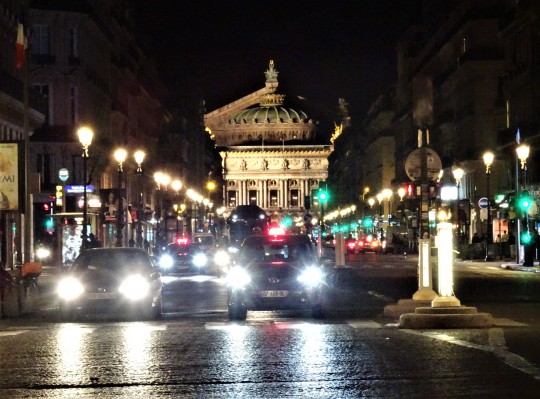
The long trek back home. The Palais over our shoulder
Tomorrow, Madame Butterfly and Opera Bastille.
0 notes
Photo

Effigy of an unknown woman in the Abbaye Notre-Dame de Villeneuve, illustrated by Louis Boudan. Date of effigy unknown, monastery founded in 1201
70 notes
·
View notes
Text

Marie de Médicis by Louis Boudan.
#louis boudan#marie de médicis#reine de france#vive la reine#royaume de france#maison de bourbon#casato di medici
5 notes
·
View notes
